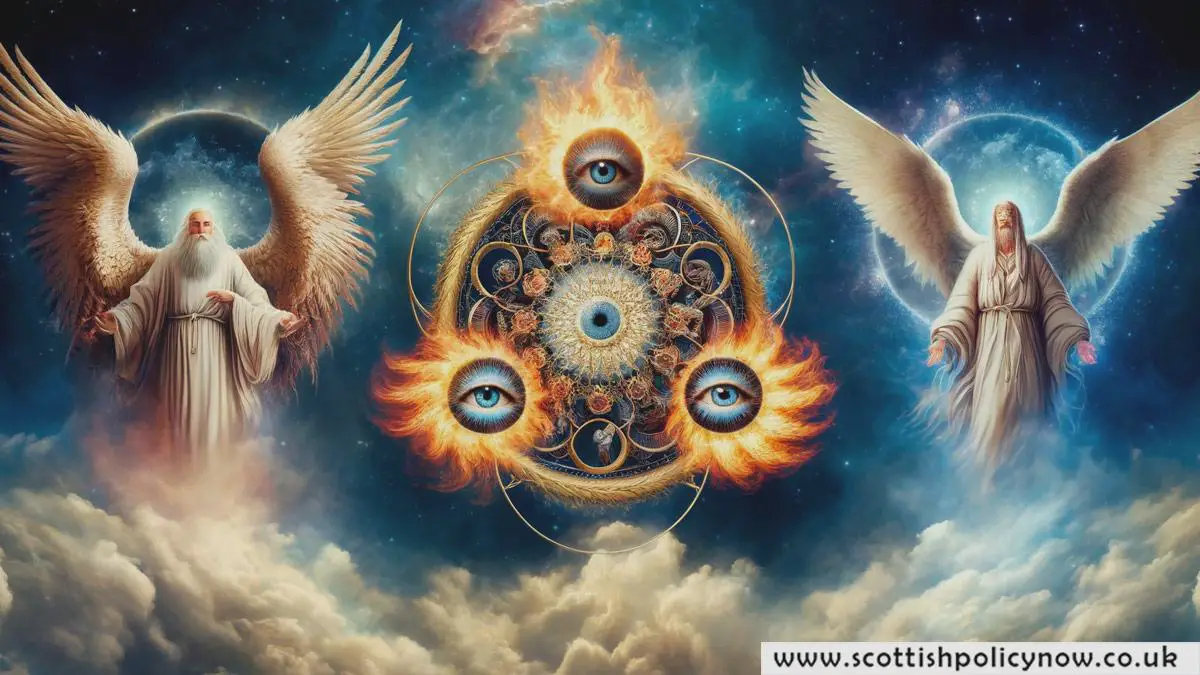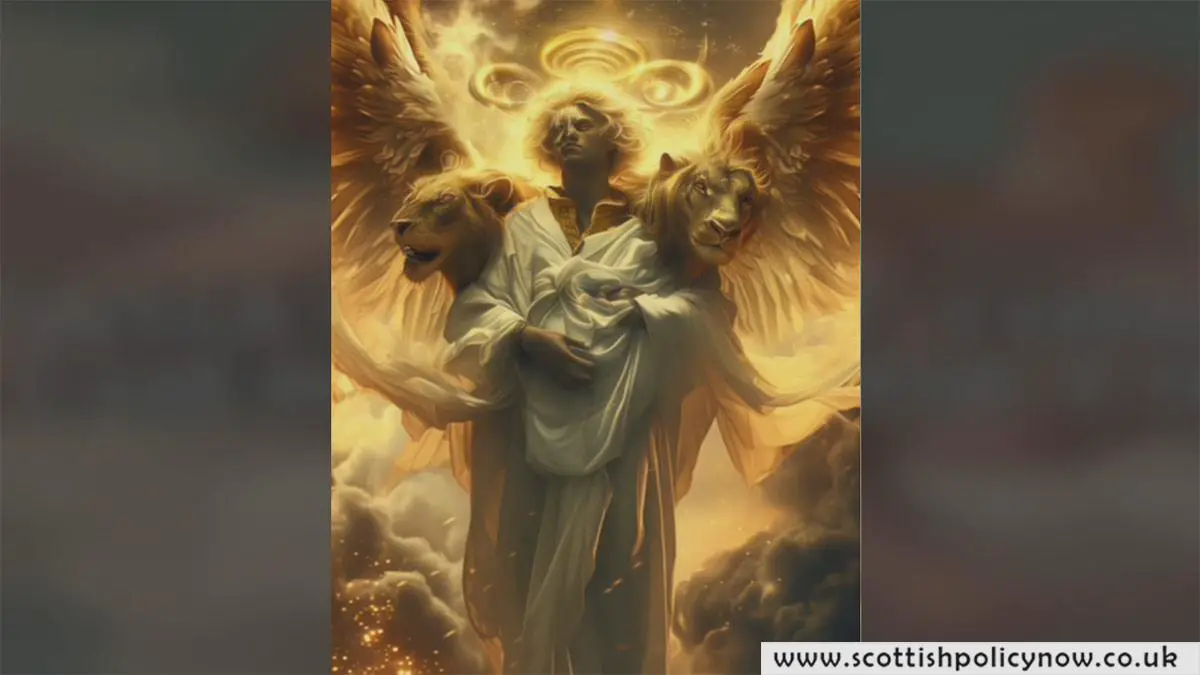Resplendent human-like figures clad in shining armors, magnificent wings, flawless visages, and a wholly virtuous demeanor that imparts warmth, comfort, and peace — such is our conception of angels. Indeed, this is the depiction that has prevailed across centuries in every form of art and literature.
Does this prevalent portrayal reflect our reimagined ideas, or does it bear a profound likeness to the celestial beings that govern paradise?
According to scripture, it seems we are mistaken. Contrary to the serene, humanoid figures we know, angels are portrayed as bizarre, even daunting. And there seems to be a valid reason for this.

Tracing Angelic Concepts: A Concise History
The term “angel” originates from several sources. It comes from the Greek “angelos,” which itself is derived from the Hebrew “Mal’ akh,” meaning messenger.
In envisioning an angel, we often picture the Malakim, who served as God’s agents in the Old Testament to execute his will and functioned as messengers in the New Testament.
Malakim are often described as the most human-like of angels. However, they are not depicted with wings in the scriptures.
Indeed, the earliest known Christian depiction of an angel, dating back to the mid-third century, shows them as human-like figures without wings.
This portrayal, however, evolved in the late fourth century as artists began to depict angels with wings to symbolize their heavenly nature, even though the scriptures do not specifically attribute wings to them.
Famous Angels and Their Scriptural Representations
Let’s examine some popular visualizations of angels and compare them to their scriptural counterparts.
Cherubim
The Bible assigns cherubim the duty of guarding the Garden of Eden — the scriptural terrestrial paradise — from humans after Adam and Eve were expelled from this divine garden.
In the Book of Ezekiel, the prophet’s vision describes cherubim with four faces — those of an eagle, a human, an ox, and a lion.

Cherubim possess upright legs, four wings (with one pair covering their bodies and the other pair used for flying), and hooves like a bull for feet. This image is far removed from our typical conceptions. Known as cherubs, they are often represented in art as plump, adorable, nude infants with wings, a style reintroduced by Renaissance artists through the ancient concept of putti.
Such artistic representations link cherubim to divinity. These creaturely hybrids have also been likened to cupids, the diaper-wearing, chubby infants often depicted with a trumpet and arrow, symbolizing romantic love.
This contemporary visual is sometimes traced back to cupid-like figures from Greek and Roman mythology. Conversely, their Biblical representation is thought to be influenced by cultural interactions with ancient civilizations like Babylonia, Egypt, and Syria, accounting for their composite form.
Seraphim
In the hierarchy of Christian angels, seraphim occupy the top tier. In artwork, the four-winged cherubim are depicted in blue to represent the sky, while the six-winged seraphim are shown in red, symbolizing fire.
The Hebrew word “Saraph” translates to “venomous desert snake,” and “Seraph” means “to burn,” reflecting the dual historical influences on the name of Seraphim.
Scripture details seraphim as having six wings, with four used to cover their faces and feet in God’s presence as a gesture of humility, and the other two for flying.

They hold a secondary rank in the angelic order, radiating sanctity. Unlike ophanim and cherubim, seraphim do not serve as guardians. Prophet Isaiah depicts seraphim as celestial beings that constantly worship God by encircling His throne and chanting “Holy, holy, holy is the Lord Almighty; the whole earth is full of his glory” in harmony as God draws near.
While they embody helpfulness and forgiveness, their appearance provokes fear in the prophet.
Some historians believe that the portrayal of Seraphim’s wings and fiery aspect might derive from their association with Egyptian iconography and the depiction of the cobra.
Ophanim
“Their whole bodies, as well as their backs, hands, and wings, were covered with eyes all around, as were their four wheels.” (Ezekiel 10:12)
Ophanim, or “the wheels,” rank among the most unusual and mystifying entities described in Ezekiel’s visions. They appear as structures composed of interlocked golden wheels, each wheel festooned with multiple sets of eyes on its exterior.
These wheels, however, remain fixed in orientation as the beings glide through the heavens. The second book of Enoch refers to ophanim as “the many-eyed.” They are sometimes also depicted as orbs or vortexes. Additionally, they are categorized as “thrones.”

An intriguing hypothesis suggests that the ophanim serve as the wheels of God’s chariot. Others, like former NASA engineer Jose F. Blumrich, argue that the ophanim could represent ancient UFO sightings.
Though not traditionally categorized as angels in the Bible, within the Jewish angelic hierarchy, they are seen as guardians of God’s throne and among the angels closest to God. This view aligns with various other cultural beliefs.
Yet, the enigmatic nature of ophanim lacks a clear historical foundation, leading some to theorize that Ezekiel’s description of these wheeled beings was influenced by psychedelic substances.
Thus, the ophanim might symbolize the inscrutable mystery of God that humans cannot fully grasp, or they could act as a device of the Lord’s chariot enabling multi-dimensional travel. The truth remains elusive.
Why Angels Look The Way They Do
Our depiction of angels with flowing white garments, halos, and graceful wings stems from artistic and fictional interpretations. Authentic religious texts describe most angels as surreal, frightening entities.
So, what accounts for this discrepancy?
It begins with the standard preface during angelic visits. Upon encountering humans, angels typically start with “do not be afraid,” rather than greetings or congratulations.
This indicates that angels might inherently provoke fear in those who behold them, contrasting with the peace and solace we typically associate with them.
This is not to discount the existence of human-like angels in heaven. However, since they do not alter our established image of angels, we’ll concentrate on the scripturally accurate ones, who might indeed be terrifying.
Now, if Genesis asserts, “God saw everything that he had made, and indeed, it was very good,” suggesting that God’s creations are inherently beautiful, why then are angels designed to be fearsome rather than beautiful?
One theory proposes that angels’ terrifying nature stems from our inability to comprehend their otherworldly forms. They are powerful beings dedicated to serving God, and their presence can radiate overwhelming power.
Another theory posits that angels, as spiritual beings existing beyond time and space, challenge our ability to faithfully recreate their image. The task of translating their divine aura and supernatural strength into familiar visual patterns can be daunting, often resulting in a disconcerting representation in our minds.
This explains why we liken their appearance to known earthly creatures, which are more easily recognizable.
Think It Can’t Get Any Stranger?
Guess Again As if the depiction of angels in the Scriptures wasn’t eerie enough, the Book of Ezekiel also reveals that the cherubs, those same plump little darlings that flit about firing arrows of love, were accompanied by Ophanims.
Indeed, the same wheel-shaped entities with interlocked wheels shining like topaz and covered with eyes on their surfaces.
This would surely stir a feeling almost bordering on intense fear — quite removed from the divine image we conjure up when picturing two angels collaborating seamlessly to fulfill God’s commands and spread peace and light across the world.
The ophanim, or the many-eyed ones, only proceed in the direction of the cherubim, leading some to speculate that cherubs hold a higher rank than ophanims. It’s also thought that the spirit of the cherubim resides within the ophanim.
Regarding their mobility, cherubs possess four faces and seraphim look in four directions, so neither needs to rotate to change direction. They sail smoothly across the heavens executing God’s plans.
Will We Ever Witness Angels in Their Scriptural Forms?
Through the ages, we’ve reshaped our view of angels to fit our ideal — magnificent, pure, and spotless human-like figures with heavenly faces and wings.
Though our perceptions have evolved over time, it’s held that if we prove ourselves worthy, we might coexist with these bizarre, celestial beings and observe their true appearances in heaven.
This notion, frankly, can be quite unsettling.
Nonetheless, looks can be deceiving. Angels, regardless of their form, are devoted worshipers that offer all glory to God and act solely on his directive. This suggests they are inherently benevolent, even when we might not realize it.








